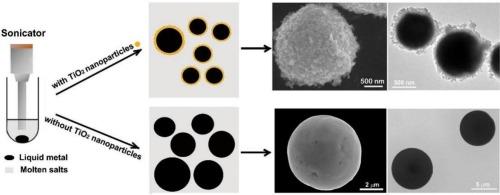One-step synthesis of Sn-based phase change material capsules via TiO2 nanoparticles-stabilized metal-in-salt emulsions
IF 5.4
3区 化学
Q1 CHEMISTRY, INORGANIC & NUCLEAR
引用次数: 0
Abstract
Conventional synthesis of stable metal oxide-encapsulated metal particles typically requires two-stage processing: metal particle formation and oxide coating via a sol-gel method. However, this biphasic protocol is often time-consuming and environmentally unfriendly. Herein, a novel, one-step approach that enables concurrent metal particle formation and oxide encapsulation is proposed to synthesize TiO₂-encapsulated Sn-based particles. The proposed method involves ultrasonic emulsification of molten Sn or Sn alloys (e.g. Sn-Zn-Cu) within a LiCl-KCl-CsCl eutectic melt containing TiO₂ nanoparticles, followed by rapid emulsion solidification and salt matrix dissolution in water. Our results demonstrate that Sn-based capsules with diameters ranging from hundreds of nanometers to several micrometers and TiO₂ shell thicknesses typically in the range of 80–120 nm were successfully synthesized via such emulsion-based system, where the capsule size decreases with the concentration of TiO₂ nanoparticles. The as-prepared Sn-2.0Zn-1.5Cu (in wt%) phase change capsules exhibit significantly reduced undercooling (∼7 °C vs. ∼88 °C for Sn capsules of comparable size) and their phase change properties remain stable after 300 thermal cycles, thereby showing great potential for thermal energy storage applications. With short emulsification durations (<10 min) and recyclable chloride salts, this Pickering-type metal-in-salt emulsion methodology might serve as a new pathway for rapid and environmentally friendly synthesis of metal-based micro/submicro-capsules across diverse material systems by varying metal alloy compositions and selecting suitable nanoparticle stabilizers.

纳米TiO2稳定盐中金属乳液一步合成锡基相变材料胶囊
传统的稳定金属氧化物包封金属颗粒的合成通常需要两个阶段的处理:金属颗粒的形成和通过溶胶-凝胶法的氧化物涂层。然而,这种双相协议通常既耗时又不环保。本文提出了一种新颖的一步方法,可以同时形成金属颗粒和氧化物包封,以合成tio2包封的锡基颗粒。所提出的方法是在含有tio2纳米颗粒的LiCl-KCl-CsCl共晶熔体中对熔融锡或锡合金(例如Sn- zn - cu)进行超声乳化,然后进行快速乳化和盐基体在水中溶解。研究结果表明,通过该乳化体系可以成功合成sn基微胶囊,其直径从数百纳米到几微米不等,tio2壳厚通常在80-120 nm之间,其中微胶囊的尺寸随着tio2纳米颗粒浓度的增加而减小。制备的Sn-2.0 zn -1.5 cu (wt%)相变胶囊的过冷度显著降低(相对于同等尺寸的Sn胶囊的过冷度为~ 7°C和~ 88°C),并且在300次热循环后其相变性能保持稳定,因此在热能储存应用中显示出巨大的潜力。该方法具有乳化时间短(10分钟)和可回收氯盐的特点,可以通过改变金属合金成分和选择合适的纳米颗粒稳定剂,在不同的材料体系中快速、环保地合成金属基微/亚微胶囊。
本文章由计算机程序翻译,如有差异,请以英文原文为准。
求助全文
约1分钟内获得全文
求助全文
来源期刊

Inorganic Chemistry Communications
化学-无机化学与核化学
CiteScore
5.50
自引率
7.90%
发文量
1013
审稿时长
53 days
期刊介绍:
Launched in January 1998, Inorganic Chemistry Communications is an international journal dedicated to the rapid publication of short communications in the major areas of inorganic, organometallic and supramolecular chemistry. Topics include synthetic and reaction chemistry, kinetics and mechanisms of reactions, bioinorganic chemistry, photochemistry and the use of metal and organometallic compounds in stoichiometric and catalytic synthesis or organic compounds.
 求助内容:
求助内容: 应助结果提醒方式:
应助结果提醒方式:


